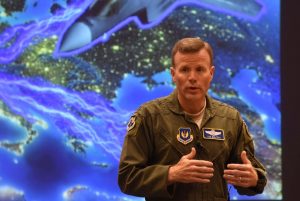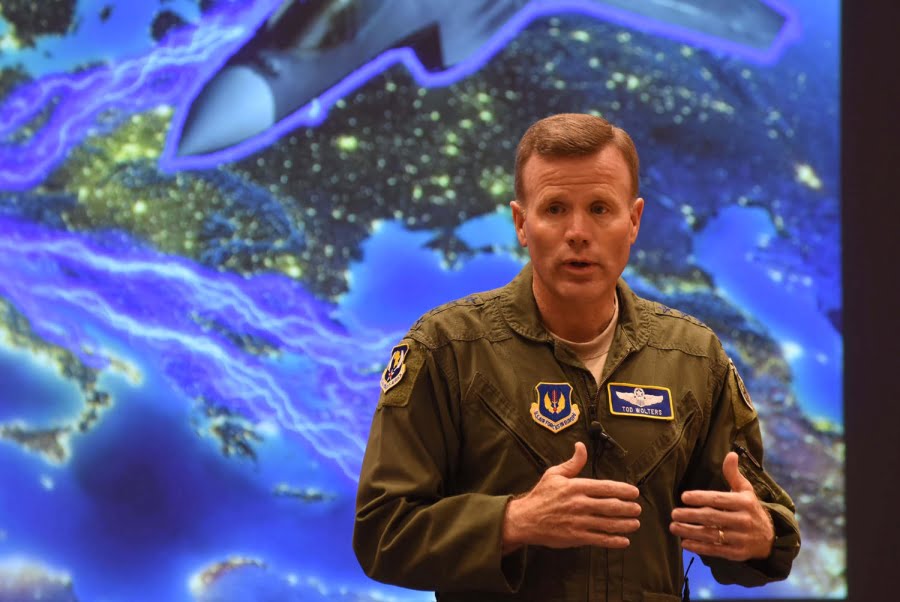2017-07-22 Earlier we highlighted the key way in which allies are leading the way for the United States in standing up F-35 squadrons abroad.
A key dynamic in the shift from COIN-centric land wars to a twenty-first century combat force is what the US and its closest allies will learn from each other thanks to the core weapons systems they are buying at the same time.
Hidden in plain view is the emergence of a significant driver of change –- flying the same aircraft at the same time and learning from each other.
A case in point is the F-35. There was much press on the recent arrival of Air Force F-35As in Europe, landing at RAF Lakenheath, operating from there and then some of those aircraft going to Estonia and then Bulgaria.
The Supreme Allied Command Europe (SACEUR) himself showed up at Lakenheath to underscore how significant the arrival of these aircraft was.
For example, in a Wall Street Journal article by Robert Wall, “US Jet Fighters Flex Muscle Amid Russia Tensions,” the arrival of the USAF jets in the UK and in Europe is highlighted.
Wall notes that the U.S. does not intend to permanently deploy the jets in Europe until 2020, and that “several allied air forces, are also buyers.”
But missing in plain view (or perhaps plane view) is the reality of the F-35 global enterprise created before the arrival of any permanent U.S. deployment, and that that global enterprise is being laid down by the US and its allies, not just the U.S. by itself.

JENNIFER H. SVAN/STARS AND STRIPES
And in a recent article by Jennifer Svan published in Stars and Stripes on July 21, 2017, the key role allies are playing in USAFE’s standup of its own squadrons was highlighted.
The U.S. Air Force has yet to stand up a squadron of F-35s in Europe, but it’s already working on how to integrate the fifth-generation combat jet with some of its closest allies in the region…..
The two-day forum on the F-35 Joint Strike Fighter served to promote cooperation among the U.S. and its European counterparts that are already flying the plane or plan to do so.
The goal was to share lessons learned and build common approaches that will support integrated flying operations in Europe in the future.
“We have to find a way to nest it all together,” said Gen. Tod Wolters, USAFE and Air Forces Africa commander.
“At the end of the day, if we can say this is something that we’re fusing into the system … we’re in a great place,” he told the group, which included fighter pilots, base commanders and chiefs of staff. The Army, NATO and the Marine Corps also sent representatives, as did Lockheed Martin, the F-35 Lightning II manufacturer.
The forum, which concluded late Thursday, was the first of its kind in Europe, officials said. It followed a similar conference held in March in the Pacific, where Japan, South Korea and Australia have all purchased the F-35.
Joining the U.S. at the European forum were Israel, Italy, Denmark, Norway, the Netherlands, the United Kingdom and Turkey. Those nations have all purchased the aircraft. Israel and Italy are the first to be flying the plane in the region.
“We like to remind (people that) Italy was the first nation to fly the airplane overseas, across the Atlantic, so we are very proud of that,” said Maj. Gen. Aurelio Colagrande, chief of staff of Italy’s air command, noting that his country’s air force currently has three F-35s in its inventory…..
Of course, one could underscore that naval aviation is already leading the way as the USMC has not only embraced the F-35 but has accelerated the general operational learning curve for the entire F-35 global enterprise.
Looking at Red Flag 17-3 from a Marine Corps Point of View from SldInfo.com on Vimeo.


